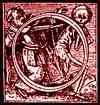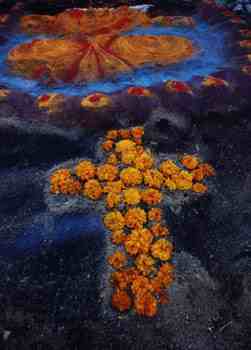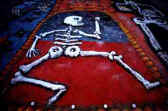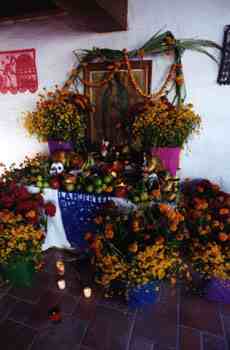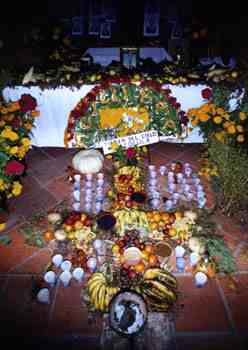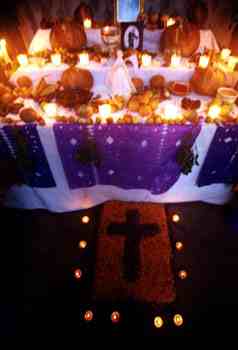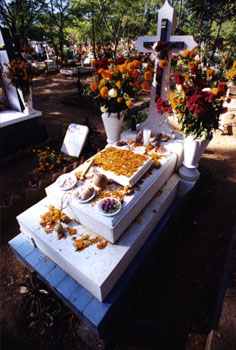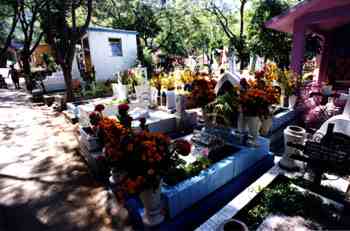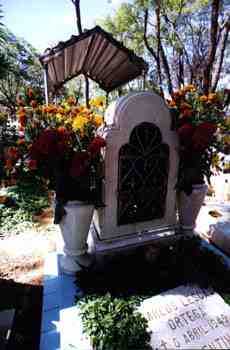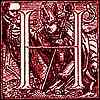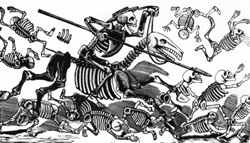
"Don Quixote" by Jose Guadalupe Posada
DAY OF THE DEAD IN OAXACA
This article is
from:http://www3.sympatico.ca/nancy.kilpatrick/
day_of_the_dead.htm
|
|
he 1 hour flight to Oaxaca from Mexico City took us over gorgeous, sparsely-populated mountains. Suddenly, an enormous valley came into view--the city of Oaxaca and the many towns that compose its environs. |
|
|
axaca has a largely Indian population which uses traditional languages, and Spanish. Little English is spoken here. We came to this remote region because we are fascinated with the Day of the Dead celebrations. Some of the events include a parade in the middle of town with stilt-walkers, and people dressed as skeletons, an incredible competition of ofrendas (altars), and sand paintings done on the streets. While there, we also visited the markets. Black pottery originates here, and I purchased a large black clay crucifix. We also saw the delicate wooden skeletons made in the region. |
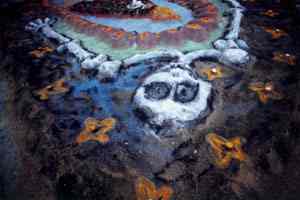
Skeleton surrounding the Virgin of Guadalupe.
|
|
|
|
|
he Day of the Dead is actually two days. Noon October 31 to noon November 1 is the day devoted to the children who have departed. Noon of November 1 to noon November 2 is for deceased adults. While Mexicans grieve for their dead loved ones, they also celebrate their memory. And a certain joy is associated with death--those who have passed on are in a better place, free of the problems of this life.
|
|
An altar with the Virgin of Guadalupe. |
An altar with a display of candles. |
|
|
he celebrations involve visits to homes of the citizens where colorful elaborate altars have been built to honor the memory of the departed. Adorning the altars are many red flowers and yellow marigolds (the flowers of the dead)---as well as cooked foods, fruits and nuts, candles and incence made from the resin of the copal tree, pictures of Jesus or the Virgin, and charming tiny dead figures that make a little fun of the one who has died. For instance, if a man was a drinker, there might be a folk-art figure downing the contents of a tequila bottle. The altars also contain things the loved one enjoyed, like cigars, or a special food. Often there is Pain de Muertos, bread of the dead, with a small effigy of the missed one imbedded into the cooked dough. One woman gave us bread from her altar--the recipe varies from region to region. In Oaxaca, it is a dry dough, porous, a bit like a biscuit--my piece held the little female head, the symbol of the departed woman. And every altar contains a glass of water because "the dead get thirsty after their long journey home." The food on the altar is consumed by the family at the end of the celebrations.
|
|
|
|
|
he other important aspect of this holiday is a visit to the cemetery. Families spend days cleaning and painting the graves, turning the topsoil, planting flowers. We went to two cemeteries on both days and found people praying, laughing, singing, sleeping and cooking food to eat while they spent hours at work that continued well past sunset.. We bought a sheet of newsprint with poems extolling the virtues of the dead. Sounds drifted through the air--mass prayers, children playing with skeleton toys as they consumed sugar shaped into little skulls bearing the names of the dead relative, Mariachi bands strolled from grave to grave to play and sing a song for the deceased for a few Pesos. Outside the gates the atmosphere after dark is carnival-like, with neon-lit amusement rides, games of chance, and concession stands offering a range of edibles including square tortillas with a red powdered coating, and something that looked like tree bark. One man with a microphone auctionied off carpets.
|
|
Grave with flowers and food. |
|
|
|
|
|
alloween has infringed on this holiday that blends Spanish Christian and Indian pre-Christian beliefs, but Oaxaca is one of the few remaining places in Mexico where el Dia de los Muertos is celebrated with more than a nod towards tradition. The dead are gone. They are missed, and mourned, but they are also remembered fondly by those who remain behind, with humor, and a light spirit. Death, it is believed, leads to a better realm,. And the hope of reunion is eternal. |
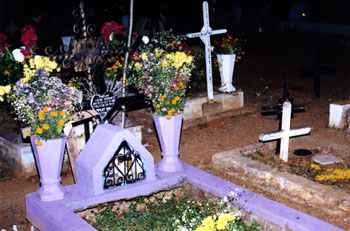
A grave on the night of the Day of the Dead.
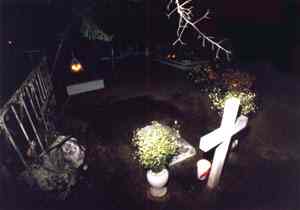
Remnants of the days of celebration.
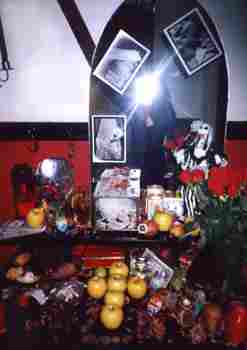
This is the ofrenda we built upon our return. Alas, no marigolds in
Montreal in November.
We held a fiesta, with our wonderful friends, and enjoyed the tequila
and mescal (with the worm)!

